Analysis of Financial Statements, Business Structures, and Budgets
VerifiedAdded on 2020/11/12
|9
|2580
|466
Report
AI Summary
This report provides a comprehensive overview of financial statements, business organizations, and budgeting. It begins by explaining the three primary financial statements: the income statement, balance sheet, and cash flow statement, along with their key users like customers, investors, and government entities. The report then delves into the three primary types of business organizations: sole proprietorships, partnerships, and corporations, outlining their characteristics and differences. Finally, it discusses the concept of a budget, including its inflows, outflows, types, and importance to a business. The report emphasizes the significance of financial information for stakeholders and the role of budgeting in effective financial planning and management. The report is a useful guide for students studying finance and business.

QUESTION
Paraphrase This Document
Need a fresh take? Get an instant paraphrase of this document with our AI Paraphraser
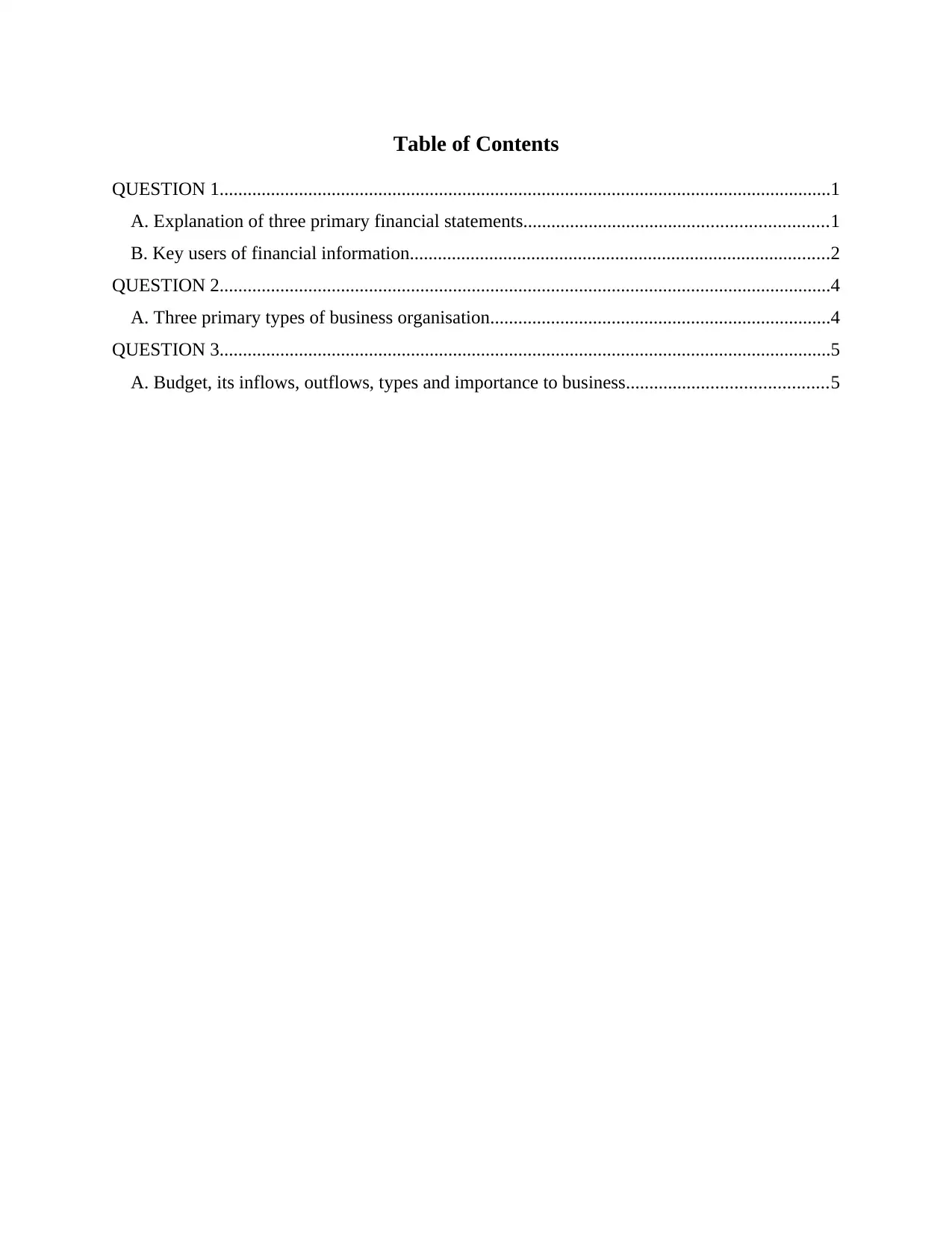
Table of Contents
QUESTION 1...................................................................................................................................1
A. Explanation of three primary financial statements.................................................................1
B. Key users of financial information..........................................................................................2
QUESTION 2...................................................................................................................................4
A. Three primary types of business organisation.........................................................................4
QUESTION 3...................................................................................................................................5
A. Budget, its inflows, outflows, types and importance to business...........................................5
QUESTION 1...................................................................................................................................1
A. Explanation of three primary financial statements.................................................................1
B. Key users of financial information..........................................................................................2
QUESTION 2...................................................................................................................................4
A. Three primary types of business organisation.........................................................................4
QUESTION 3...................................................................................................................................5
A. Budget, its inflows, outflows, types and importance to business...........................................5

⊘ This is a preview!⊘
Do you want full access?
Subscribe today to unlock all pages.

Trusted by 1+ million students worldwide
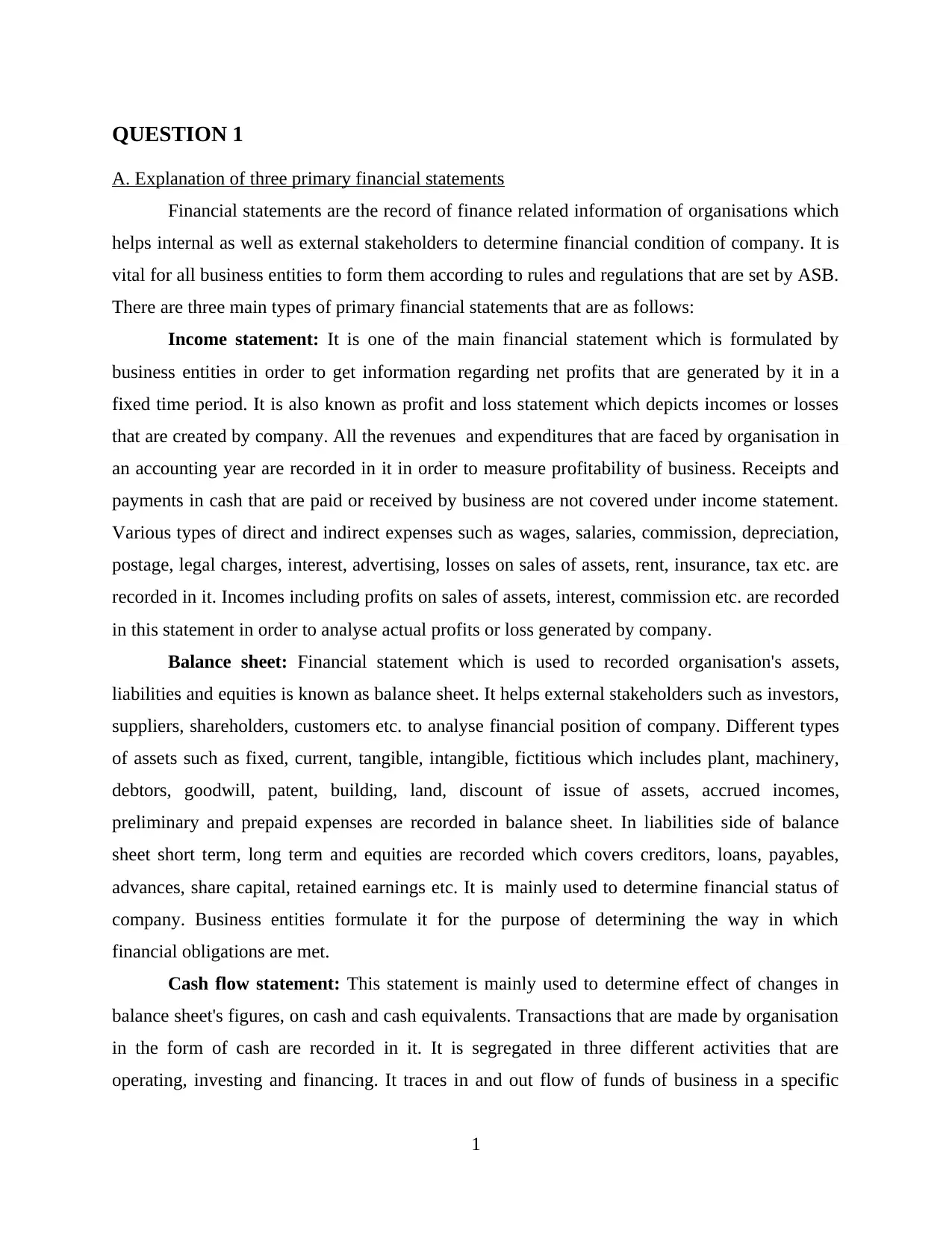
QUESTION 1
A. Explanation of three primary financial statements
Financial statements are the record of finance related information of organisations which
helps internal as well as external stakeholders to determine financial condition of company. It is
vital for all business entities to form them according to rules and regulations that are set by ASB.
There are three main types of primary financial statements that are as follows:
Income statement: It is one of the main financial statement which is formulated by
business entities in order to get information regarding net profits that are generated by it in a
fixed time period. It is also known as profit and loss statement which depicts incomes or losses
that are created by company. All the revenues and expenditures that are faced by organisation in
an accounting year are recorded in it in order to measure profitability of business. Receipts and
payments in cash that are paid or received by business are not covered under income statement.
Various types of direct and indirect expenses such as wages, salaries, commission, depreciation,
postage, legal charges, interest, advertising, losses on sales of assets, rent, insurance, tax etc. are
recorded in it. Incomes including profits on sales of assets, interest, commission etc. are recorded
in this statement in order to analyse actual profits or loss generated by company.
Balance sheet: Financial statement which is used to recorded organisation's assets,
liabilities and equities is known as balance sheet. It helps external stakeholders such as investors,
suppliers, shareholders, customers etc. to analyse financial position of company. Different types
of assets such as fixed, current, tangible, intangible, fictitious which includes plant, machinery,
debtors, goodwill, patent, building, land, discount of issue of assets, accrued incomes,
preliminary and prepaid expenses are recorded in balance sheet. In liabilities side of balance
sheet short term, long term and equities are recorded which covers creditors, loans, payables,
advances, share capital, retained earnings etc. It is mainly used to determine financial status of
company. Business entities formulate it for the purpose of determining the way in which
financial obligations are met.
Cash flow statement: This statement is mainly used to determine effect of changes in
balance sheet's figures, on cash and cash equivalents. Transactions that are made by organisation
in the form of cash are recorded in it. It is segregated in three different activities that are
operating, investing and financing. It traces in and out flow of funds of business in a specific
1
A. Explanation of three primary financial statements
Financial statements are the record of finance related information of organisations which
helps internal as well as external stakeholders to determine financial condition of company. It is
vital for all business entities to form them according to rules and regulations that are set by ASB.
There are three main types of primary financial statements that are as follows:
Income statement: It is one of the main financial statement which is formulated by
business entities in order to get information regarding net profits that are generated by it in a
fixed time period. It is also known as profit and loss statement which depicts incomes or losses
that are created by company. All the revenues and expenditures that are faced by organisation in
an accounting year are recorded in it in order to measure profitability of business. Receipts and
payments in cash that are paid or received by business are not covered under income statement.
Various types of direct and indirect expenses such as wages, salaries, commission, depreciation,
postage, legal charges, interest, advertising, losses on sales of assets, rent, insurance, tax etc. are
recorded in it. Incomes including profits on sales of assets, interest, commission etc. are recorded
in this statement in order to analyse actual profits or loss generated by company.
Balance sheet: Financial statement which is used to recorded organisation's assets,
liabilities and equities is known as balance sheet. It helps external stakeholders such as investors,
suppliers, shareholders, customers etc. to analyse financial position of company. Different types
of assets such as fixed, current, tangible, intangible, fictitious which includes plant, machinery,
debtors, goodwill, patent, building, land, discount of issue of assets, accrued incomes,
preliminary and prepaid expenses are recorded in balance sheet. In liabilities side of balance
sheet short term, long term and equities are recorded which covers creditors, loans, payables,
advances, share capital, retained earnings etc. It is mainly used to determine financial status of
company. Business entities formulate it for the purpose of determining the way in which
financial obligations are met.
Cash flow statement: This statement is mainly used to determine effect of changes in
balance sheet's figures, on cash and cash equivalents. Transactions that are made by organisation
in the form of cash are recorded in it. It is segregated in three different activities that are
operating, investing and financing. It traces in and out flow of funds of business in a specific
1
Paraphrase This Document
Need a fresh take? Get an instant paraphrase of this document with our AI Paraphraser
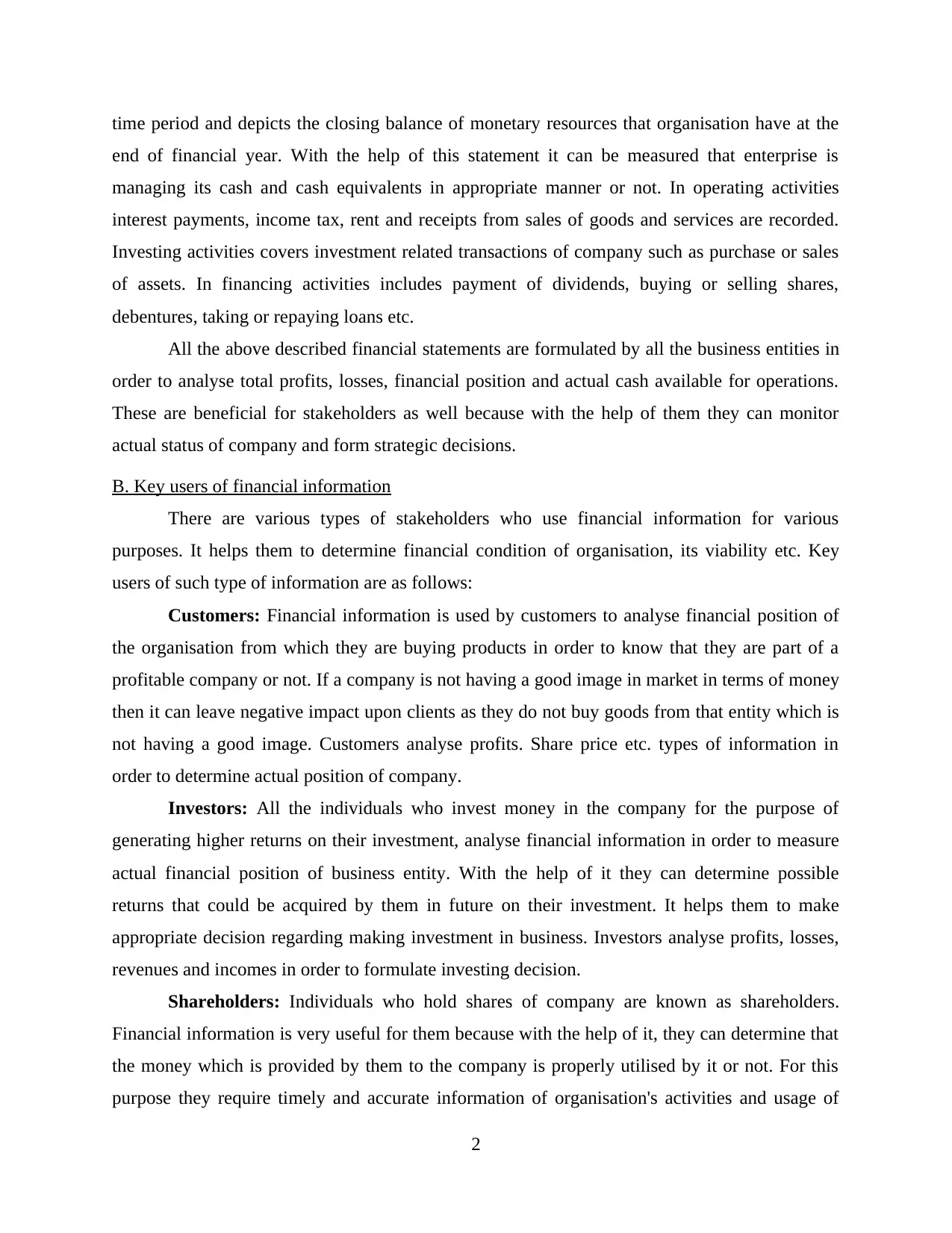
time period and depicts the closing balance of monetary resources that organisation have at the
end of financial year. With the help of this statement it can be measured that enterprise is
managing its cash and cash equivalents in appropriate manner or not. In operating activities
interest payments, income tax, rent and receipts from sales of goods and services are recorded.
Investing activities covers investment related transactions of company such as purchase or sales
of assets. In financing activities includes payment of dividends, buying or selling shares,
debentures, taking or repaying loans etc.
All the above described financial statements are formulated by all the business entities in
order to analyse total profits, losses, financial position and actual cash available for operations.
These are beneficial for stakeholders as well because with the help of them they can monitor
actual status of company and form strategic decisions.
B. Key users of financial information
There are various types of stakeholders who use financial information for various
purposes. It helps them to determine financial condition of organisation, its viability etc. Key
users of such type of information are as follows:
Customers: Financial information is used by customers to analyse financial position of
the organisation from which they are buying products in order to know that they are part of a
profitable company or not. If a company is not having a good image in market in terms of money
then it can leave negative impact upon clients as they do not buy goods from that entity which is
not having a good image. Customers analyse profits. Share price etc. types of information in
order to determine actual position of company.
Investors: All the individuals who invest money in the company for the purpose of
generating higher returns on their investment, analyse financial information in order to measure
actual financial position of business entity. With the help of it they can determine possible
returns that could be acquired by them in future on their investment. It helps them to make
appropriate decision regarding making investment in business. Investors analyse profits, losses,
revenues and incomes in order to formulate investing decision.
Shareholders: Individuals who hold shares of company are known as shareholders.
Financial information is very useful for them because with the help of it, they can determine that
the money which is provided by them to the company is properly utilised by it or not. For this
purpose they require timely and accurate information of organisation's activities and usage of
2
end of financial year. With the help of this statement it can be measured that enterprise is
managing its cash and cash equivalents in appropriate manner or not. In operating activities
interest payments, income tax, rent and receipts from sales of goods and services are recorded.
Investing activities covers investment related transactions of company such as purchase or sales
of assets. In financing activities includes payment of dividends, buying or selling shares,
debentures, taking or repaying loans etc.
All the above described financial statements are formulated by all the business entities in
order to analyse total profits, losses, financial position and actual cash available for operations.
These are beneficial for stakeholders as well because with the help of them they can monitor
actual status of company and form strategic decisions.
B. Key users of financial information
There are various types of stakeholders who use financial information for various
purposes. It helps them to determine financial condition of organisation, its viability etc. Key
users of such type of information are as follows:
Customers: Financial information is used by customers to analyse financial position of
the organisation from which they are buying products in order to know that they are part of a
profitable company or not. If a company is not having a good image in market in terms of money
then it can leave negative impact upon clients as they do not buy goods from that entity which is
not having a good image. Customers analyse profits. Share price etc. types of information in
order to determine actual position of company.
Investors: All the individuals who invest money in the company for the purpose of
generating higher returns on their investment, analyse financial information in order to measure
actual financial position of business entity. With the help of it they can determine possible
returns that could be acquired by them in future on their investment. It helps them to make
appropriate decision regarding making investment in business. Investors analyse profits, losses,
revenues and incomes in order to formulate investing decision.
Shareholders: Individuals who hold shares of company are known as shareholders.
Financial information is very useful for them because with the help of it, they can determine that
the money which is provided by them to the company is properly utilised by it or not. For this
purpose they require timely and accurate information of organisation's activities and usage of
2
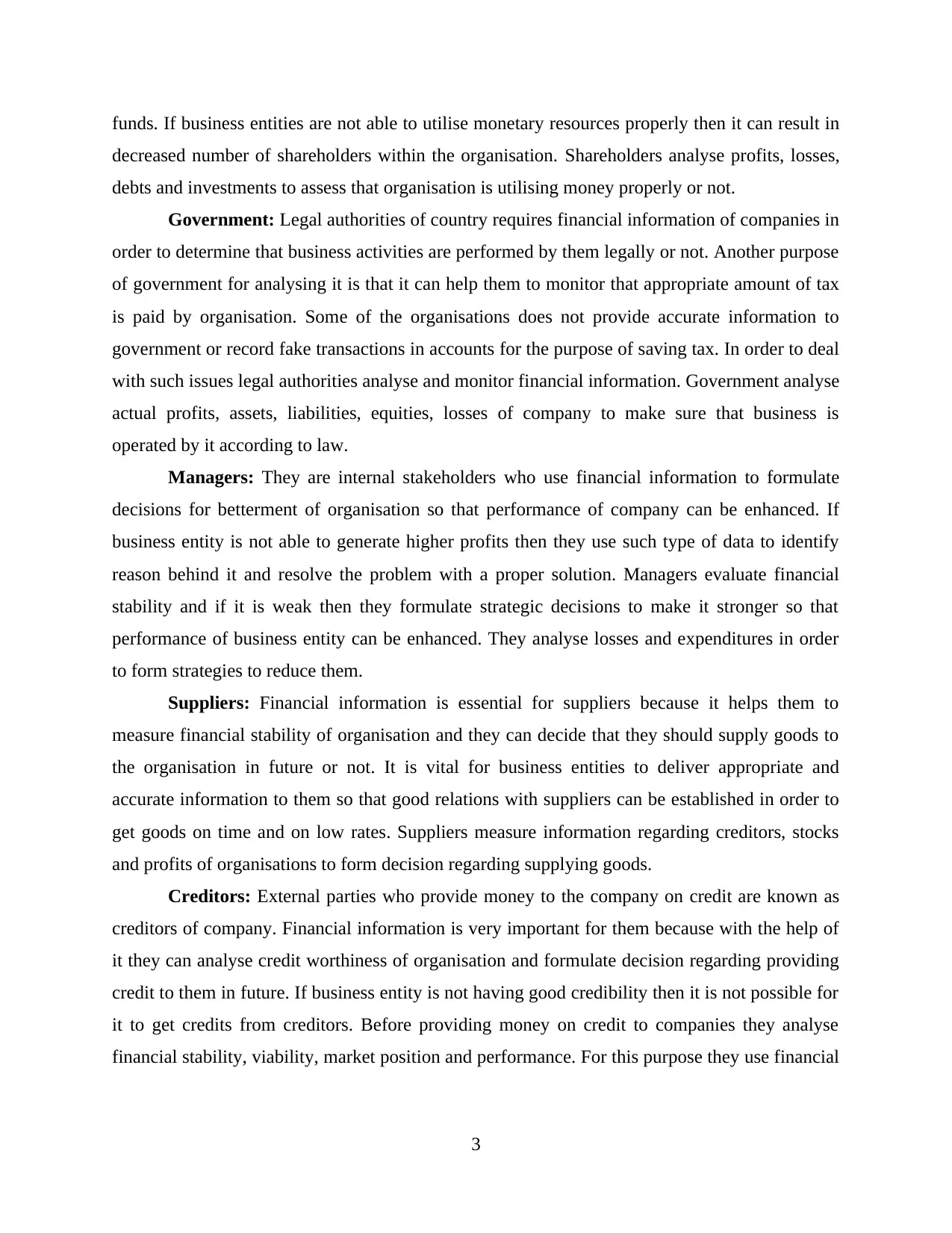
funds. If business entities are not able to utilise monetary resources properly then it can result in
decreased number of shareholders within the organisation. Shareholders analyse profits, losses,
debts and investments to assess that organisation is utilising money properly or not.
Government: Legal authorities of country requires financial information of companies in
order to determine that business activities are performed by them legally or not. Another purpose
of government for analysing it is that it can help them to monitor that appropriate amount of tax
is paid by organisation. Some of the organisations does not provide accurate information to
government or record fake transactions in accounts for the purpose of saving tax. In order to deal
with such issues legal authorities analyse and monitor financial information. Government analyse
actual profits, assets, liabilities, equities, losses of company to make sure that business is
operated by it according to law.
Managers: They are internal stakeholders who use financial information to formulate
decisions for betterment of organisation so that performance of company can be enhanced. If
business entity is not able to generate higher profits then they use such type of data to identify
reason behind it and resolve the problem with a proper solution. Managers evaluate financial
stability and if it is weak then they formulate strategic decisions to make it stronger so that
performance of business entity can be enhanced. They analyse losses and expenditures in order
to form strategies to reduce them.
Suppliers: Financial information is essential for suppliers because it helps them to
measure financial stability of organisation and they can decide that they should supply goods to
the organisation in future or not. It is vital for business entities to deliver appropriate and
accurate information to them so that good relations with suppliers can be established in order to
get goods on time and on low rates. Suppliers measure information regarding creditors, stocks
and profits of organisations to form decision regarding supplying goods.
Creditors: External parties who provide money to the company on credit are known as
creditors of company. Financial information is very important for them because with the help of
it they can analyse credit worthiness of organisation and formulate decision regarding providing
credit to them in future. If business entity is not having good credibility then it is not possible for
it to get credits from creditors. Before providing money on credit to companies they analyse
financial stability, viability, market position and performance. For this purpose they use financial
3
decreased number of shareholders within the organisation. Shareholders analyse profits, losses,
debts and investments to assess that organisation is utilising money properly or not.
Government: Legal authorities of country requires financial information of companies in
order to determine that business activities are performed by them legally or not. Another purpose
of government for analysing it is that it can help them to monitor that appropriate amount of tax
is paid by organisation. Some of the organisations does not provide accurate information to
government or record fake transactions in accounts for the purpose of saving tax. In order to deal
with such issues legal authorities analyse and monitor financial information. Government analyse
actual profits, assets, liabilities, equities, losses of company to make sure that business is
operated by it according to law.
Managers: They are internal stakeholders who use financial information to formulate
decisions for betterment of organisation so that performance of company can be enhanced. If
business entity is not able to generate higher profits then they use such type of data to identify
reason behind it and resolve the problem with a proper solution. Managers evaluate financial
stability and if it is weak then they formulate strategic decisions to make it stronger so that
performance of business entity can be enhanced. They analyse losses and expenditures in order
to form strategies to reduce them.
Suppliers: Financial information is essential for suppliers because it helps them to
measure financial stability of organisation and they can decide that they should supply goods to
the organisation in future or not. It is vital for business entities to deliver appropriate and
accurate information to them so that good relations with suppliers can be established in order to
get goods on time and on low rates. Suppliers measure information regarding creditors, stocks
and profits of organisations to form decision regarding supplying goods.
Creditors: External parties who provide money to the company on credit are known as
creditors of company. Financial information is very important for them because with the help of
it they can analyse credit worthiness of organisation and formulate decision regarding providing
credit to them in future. If business entity is not having good credibility then it is not possible for
it to get credits from creditors. Before providing money on credit to companies they analyse
financial stability, viability, market position and performance. For this purpose they use financial
3
⊘ This is a preview!⊘
Do you want full access?
Subscribe today to unlock all pages.

Trusted by 1+ million students worldwide
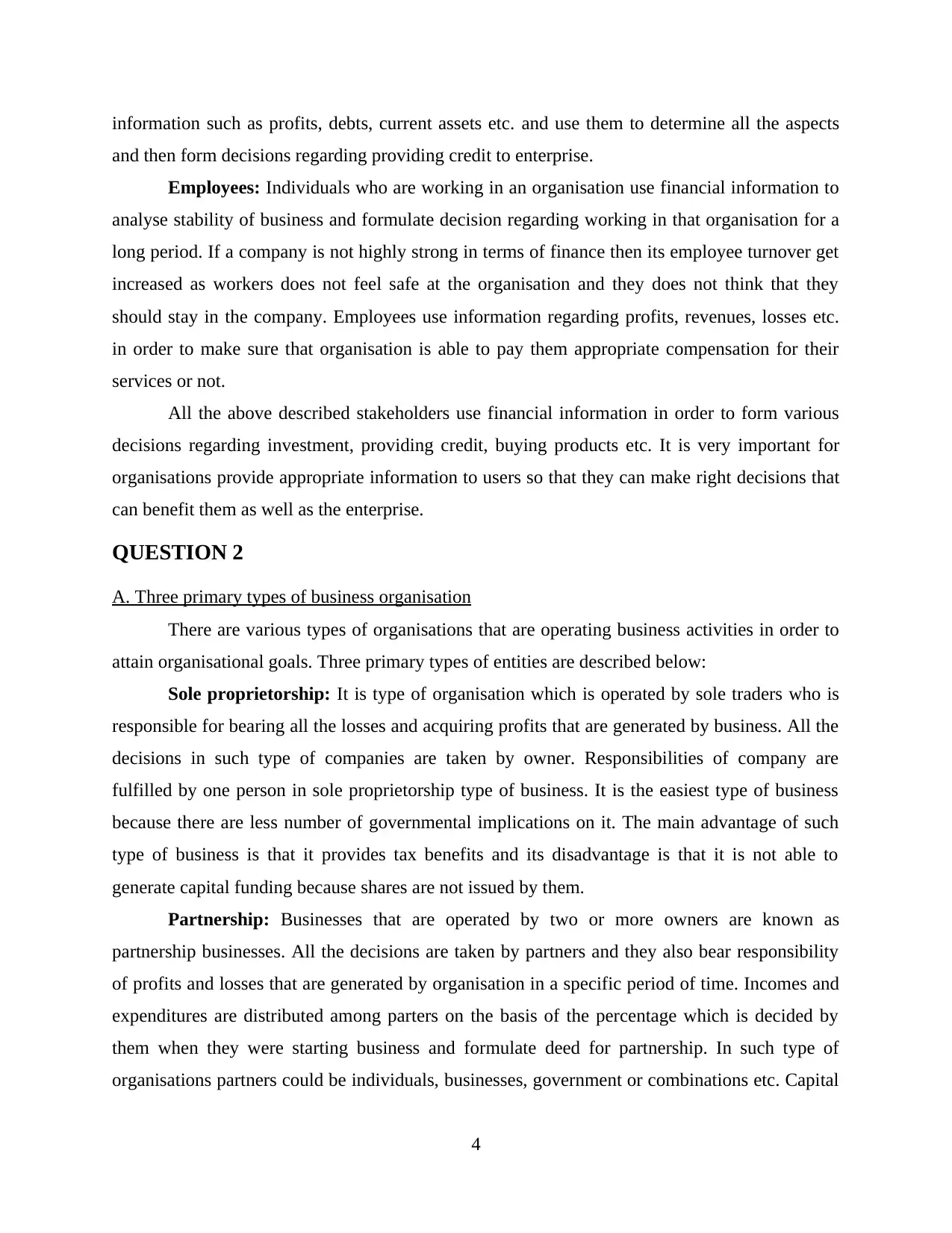
information such as profits, debts, current assets etc. and use them to determine all the aspects
and then form decisions regarding providing credit to enterprise.
Employees: Individuals who are working in an organisation use financial information to
analyse stability of business and formulate decision regarding working in that organisation for a
long period. If a company is not highly strong in terms of finance then its employee turnover get
increased as workers does not feel safe at the organisation and they does not think that they
should stay in the company. Employees use information regarding profits, revenues, losses etc.
in order to make sure that organisation is able to pay them appropriate compensation for their
services or not.
All the above described stakeholders use financial information in order to form various
decisions regarding investment, providing credit, buying products etc. It is very important for
organisations provide appropriate information to users so that they can make right decisions that
can benefit them as well as the enterprise.
QUESTION 2
A. Three primary types of business organisation
There are various types of organisations that are operating business activities in order to
attain organisational goals. Three primary types of entities are described below:
Sole proprietorship: It is type of organisation which is operated by sole traders who is
responsible for bearing all the losses and acquiring profits that are generated by business. All the
decisions in such type of companies are taken by owner. Responsibilities of company are
fulfilled by one person in sole proprietorship type of business. It is the easiest type of business
because there are less number of governmental implications on it. The main advantage of such
type of business is that it provides tax benefits and its disadvantage is that it is not able to
generate capital funding because shares are not issued by them.
Partnership: Businesses that are operated by two or more owners are known as
partnership businesses. All the decisions are taken by partners and they also bear responsibility
of profits and losses that are generated by organisation in a specific period of time. Incomes and
expenditures are distributed among parters on the basis of the percentage which is decided by
them when they were starting business and formulate deed for partnership. In such type of
organisations partners could be individuals, businesses, government or combinations etc. Capital
4
and then form decisions regarding providing credit to enterprise.
Employees: Individuals who are working in an organisation use financial information to
analyse stability of business and formulate decision regarding working in that organisation for a
long period. If a company is not highly strong in terms of finance then its employee turnover get
increased as workers does not feel safe at the organisation and they does not think that they
should stay in the company. Employees use information regarding profits, revenues, losses etc.
in order to make sure that organisation is able to pay them appropriate compensation for their
services or not.
All the above described stakeholders use financial information in order to form various
decisions regarding investment, providing credit, buying products etc. It is very important for
organisations provide appropriate information to users so that they can make right decisions that
can benefit them as well as the enterprise.
QUESTION 2
A. Three primary types of business organisation
There are various types of organisations that are operating business activities in order to
attain organisational goals. Three primary types of entities are described below:
Sole proprietorship: It is type of organisation which is operated by sole traders who is
responsible for bearing all the losses and acquiring profits that are generated by business. All the
decisions in such type of companies are taken by owner. Responsibilities of company are
fulfilled by one person in sole proprietorship type of business. It is the easiest type of business
because there are less number of governmental implications on it. The main advantage of such
type of business is that it provides tax benefits and its disadvantage is that it is not able to
generate capital funding because shares are not issued by them.
Partnership: Businesses that are operated by two or more owners are known as
partnership businesses. All the decisions are taken by partners and they also bear responsibility
of profits and losses that are generated by organisation in a specific period of time. Incomes and
expenditures are distributed among parters on the basis of the percentage which is decided by
them when they were starting business and formulate deed for partnership. In such type of
organisations partners could be individuals, businesses, government or combinations etc. Capital
4
Paraphrase This Document
Need a fresh take? Get an instant paraphrase of this document with our AI Paraphraser
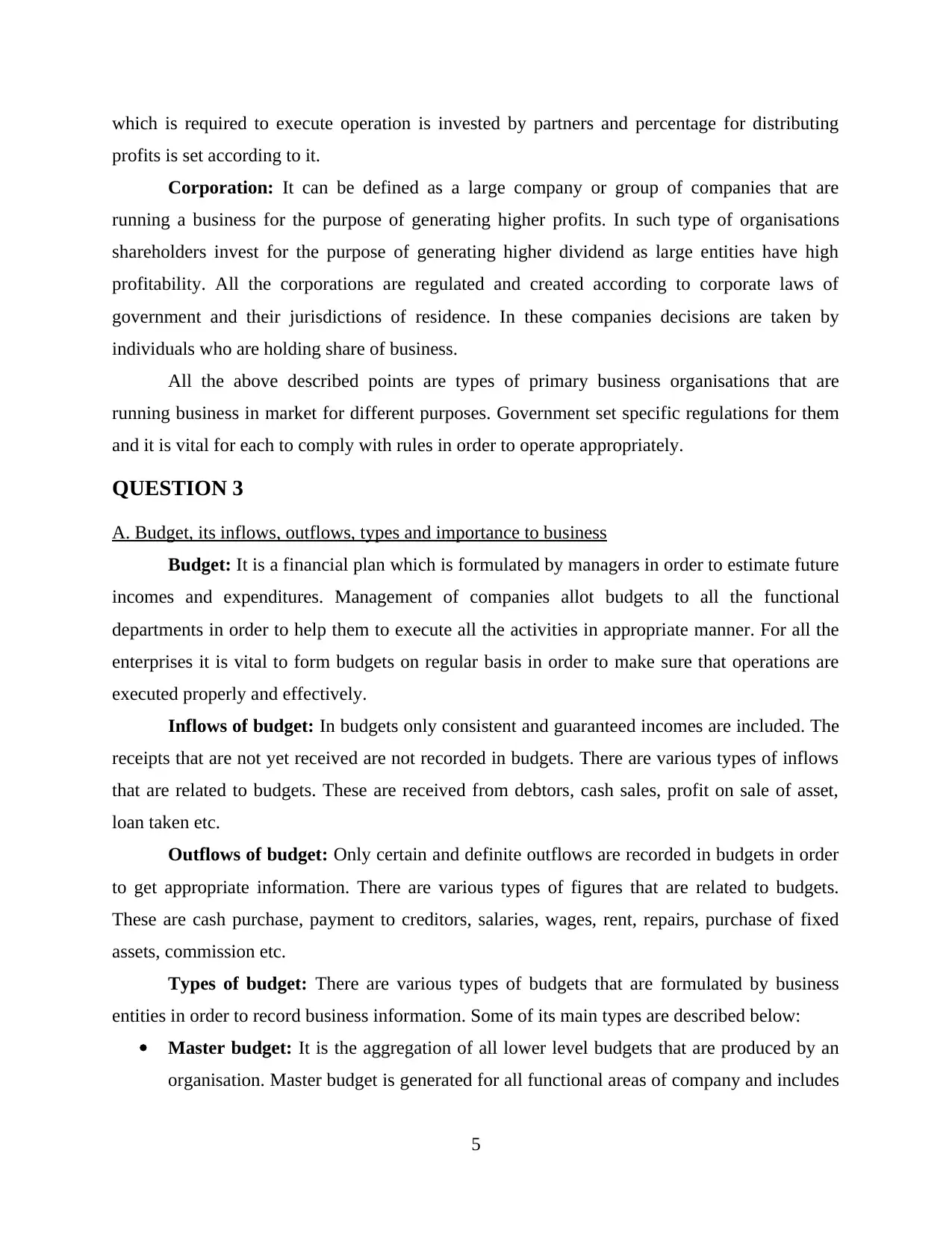
which is required to execute operation is invested by partners and percentage for distributing
profits is set according to it.
Corporation: It can be defined as a large company or group of companies that are
running a business for the purpose of generating higher profits. In such type of organisations
shareholders invest for the purpose of generating higher dividend as large entities have high
profitability. All the corporations are regulated and created according to corporate laws of
government and their jurisdictions of residence. In these companies decisions are taken by
individuals who are holding share of business.
All the above described points are types of primary business organisations that are
running business in market for different purposes. Government set specific regulations for them
and it is vital for each to comply with rules in order to operate appropriately.
QUESTION 3
A. Budget, its inflows, outflows, types and importance to business
Budget: It is a financial plan which is formulated by managers in order to estimate future
incomes and expenditures. Management of companies allot budgets to all the functional
departments in order to help them to execute all the activities in appropriate manner. For all the
enterprises it is vital to form budgets on regular basis in order to make sure that operations are
executed properly and effectively.
Inflows of budget: In budgets only consistent and guaranteed incomes are included. The
receipts that are not yet received are not recorded in budgets. There are various types of inflows
that are related to budgets. These are received from debtors, cash sales, profit on sale of asset,
loan taken etc.
Outflows of budget: Only certain and definite outflows are recorded in budgets in order
to get appropriate information. There are various types of figures that are related to budgets.
These are cash purchase, payment to creditors, salaries, wages, rent, repairs, purchase of fixed
assets, commission etc.
Types of budget: There are various types of budgets that are formulated by business
entities in order to record business information. Some of its main types are described below:
Master budget: It is the aggregation of all lower level budgets that are produced by an
organisation. Master budget is generated for all functional areas of company and includes
5
profits is set according to it.
Corporation: It can be defined as a large company or group of companies that are
running a business for the purpose of generating higher profits. In such type of organisations
shareholders invest for the purpose of generating higher dividend as large entities have high
profitability. All the corporations are regulated and created according to corporate laws of
government and their jurisdictions of residence. In these companies decisions are taken by
individuals who are holding share of business.
All the above described points are types of primary business organisations that are
running business in market for different purposes. Government set specific regulations for them
and it is vital for each to comply with rules in order to operate appropriately.
QUESTION 3
A. Budget, its inflows, outflows, types and importance to business
Budget: It is a financial plan which is formulated by managers in order to estimate future
incomes and expenditures. Management of companies allot budgets to all the functional
departments in order to help them to execute all the activities in appropriate manner. For all the
enterprises it is vital to form budgets on regular basis in order to make sure that operations are
executed properly and effectively.
Inflows of budget: In budgets only consistent and guaranteed incomes are included. The
receipts that are not yet received are not recorded in budgets. There are various types of inflows
that are related to budgets. These are received from debtors, cash sales, profit on sale of asset,
loan taken etc.
Outflows of budget: Only certain and definite outflows are recorded in budgets in order
to get appropriate information. There are various types of figures that are related to budgets.
These are cash purchase, payment to creditors, salaries, wages, rent, repairs, purchase of fixed
assets, commission etc.
Types of budget: There are various types of budgets that are formulated by business
entities in order to record business information. Some of its main types are described below:
Master budget: It is the aggregation of all lower level budgets that are produced by an
organisation. Master budget is generated for all functional areas of company and includes
5
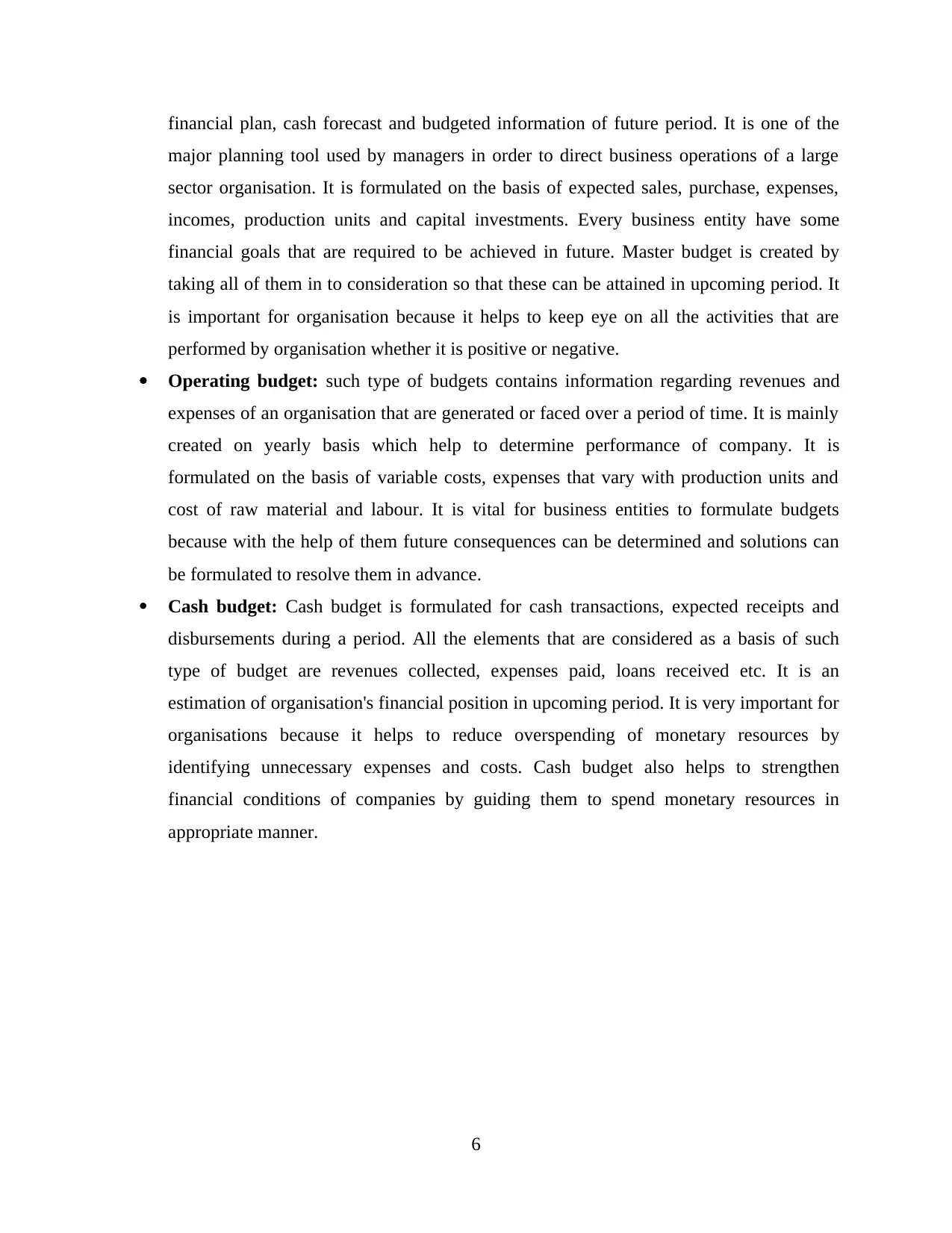
financial plan, cash forecast and budgeted information of future period. It is one of the
major planning tool used by managers in order to direct business operations of a large
sector organisation. It is formulated on the basis of expected sales, purchase, expenses,
incomes, production units and capital investments. Every business entity have some
financial goals that are required to be achieved in future. Master budget is created by
taking all of them in to consideration so that these can be attained in upcoming period. It
is important for organisation because it helps to keep eye on all the activities that are
performed by organisation whether it is positive or negative.
Operating budget: such type of budgets contains information regarding revenues and
expenses of an organisation that are generated or faced over a period of time. It is mainly
created on yearly basis which help to determine performance of company. It is
formulated on the basis of variable costs, expenses that vary with production units and
cost of raw material and labour. It is vital for business entities to formulate budgets
because with the help of them future consequences can be determined and solutions can
be formulated to resolve them in advance.
Cash budget: Cash budget is formulated for cash transactions, expected receipts and
disbursements during a period. All the elements that are considered as a basis of such
type of budget are revenues collected, expenses paid, loans received etc. It is an
estimation of organisation's financial position in upcoming period. It is very important for
organisations because it helps to reduce overspending of monetary resources by
identifying unnecessary expenses and costs. Cash budget also helps to strengthen
financial conditions of companies by guiding them to spend monetary resources in
appropriate manner.
6
major planning tool used by managers in order to direct business operations of a large
sector organisation. It is formulated on the basis of expected sales, purchase, expenses,
incomes, production units and capital investments. Every business entity have some
financial goals that are required to be achieved in future. Master budget is created by
taking all of them in to consideration so that these can be attained in upcoming period. It
is important for organisation because it helps to keep eye on all the activities that are
performed by organisation whether it is positive or negative.
Operating budget: such type of budgets contains information regarding revenues and
expenses of an organisation that are generated or faced over a period of time. It is mainly
created on yearly basis which help to determine performance of company. It is
formulated on the basis of variable costs, expenses that vary with production units and
cost of raw material and labour. It is vital for business entities to formulate budgets
because with the help of them future consequences can be determined and solutions can
be formulated to resolve them in advance.
Cash budget: Cash budget is formulated for cash transactions, expected receipts and
disbursements during a period. All the elements that are considered as a basis of such
type of budget are revenues collected, expenses paid, loans received etc. It is an
estimation of organisation's financial position in upcoming period. It is very important for
organisations because it helps to reduce overspending of monetary resources by
identifying unnecessary expenses and costs. Cash budget also helps to strengthen
financial conditions of companies by guiding them to spend monetary resources in
appropriate manner.
6
⊘ This is a preview!⊘
Do you want full access?
Subscribe today to unlock all pages.

Trusted by 1+ million students worldwide
1 out of 9
Related Documents
Your All-in-One AI-Powered Toolkit for Academic Success.
+13062052269
info@desklib.com
Available 24*7 on WhatsApp / Email
![[object Object]](/_next/static/media/star-bottom.7253800d.svg)
Unlock your academic potential
Copyright © 2020–2025 A2Z Services. All Rights Reserved. Developed and managed by ZUCOL.





